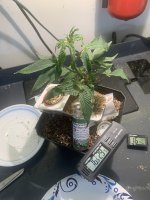daleharris
Active member
So,,question is how long can cuts be totally submerged in water ?? I have some cuts of something I really wanted on the way soon and the source told me he has had mites but has not seen any in a while. Before I even bring them in I’d like to dip them in water and hold them under for like 20 minutes and maybe repeat it a couple times in fresh water. Or if there is something I can add to the water without killing cuts. And then put them in rapid rooters in dome. And up front only one will be kept as a future mom so I don’t care what I treat them with since the one I keep will be a cut that’s grown to only to give up cuts and discarded for new moms and future grow. I don’t care if this one glows in the dark so long as no mites and it gets big enough to give up 100% bug free cuts. I have on hand Avid and the other big hitters from my one and only battle with mites.




